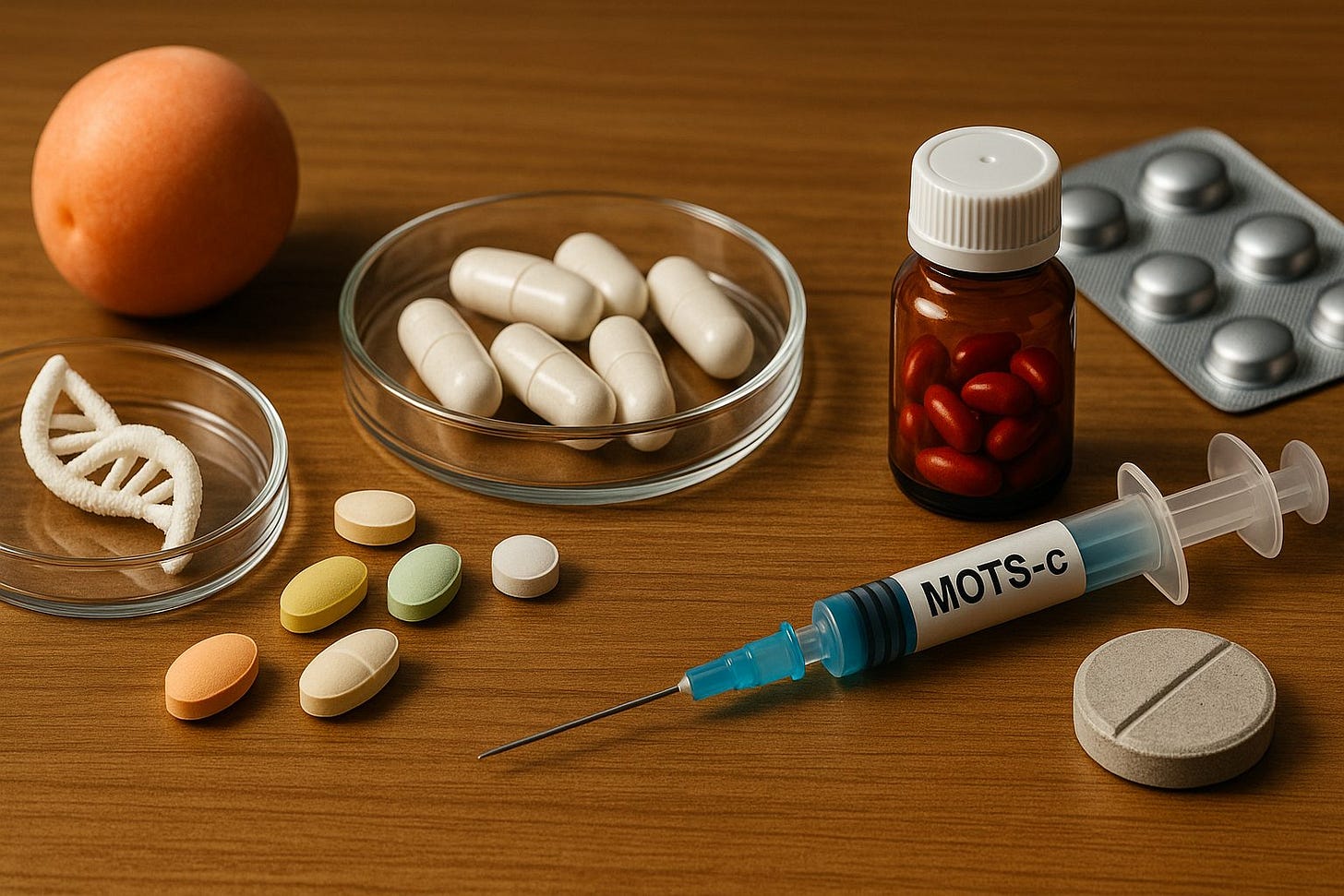Peptides, Supplements, and More: 7 Longevity Therapies That Are (Finally) Mainstream
From cellular reboots to metabolic miracles—these once-niche interventions are now in your wellness toolkit
“Longevity” once felt like sci-fi. Now? It's woven into daily routines—like coffee and morning walks—through peptides, supplements, and metabolic therapies once limited to elite labs. We’re talking next‑level interventions: telomere activators, NAD boosters, senolytics, rapamycin, and beyond. These aren’t fringe biohacks—they’re edging into mainstream medicine. This editorial journey explores seven such therapies, dissecting the science, sourcing the evidence, and keeping it real. Ready to slow your clock? Let’s go. ⏳
1. NAD⁺ Boosters: NMN & NR
When cellular energy dips, fatigue settles in. Enter NMN and NR, precursors to NAD⁺—the coenzyme that fuels repair and gene expression. Harvard's David Sinclair champions them; biohackers and celebs like Hailey Bieber and Jennifer Aniston can’t get enough. But the truth is nuanced.
Promise: small trials report improved muscle insulin sensitivity and endurance in runners.
Reality check: human lifespan impact remains unproven—and not all studies deliver strong benefits .
What experts say: Dr. Amanda Kahn and Dr. Hamdan recommend high-quality NR/NMN brands (like Tru Niagen) and medical oversight.
So yes—these boosters might level up your energy and skin tone. But they’re not a miracle pill. Combine them with exercise, nutrition, and stress reduction for real-world gains.
Related - NAD+ IV Drips: The Celebrity Longevity Secret You Can (Almost) Afford
2. Epitalon: The Telomere Whisperer
Telomeres cap chromosomes and shorten as cells replicate—so the idea that a peptide like Epitalon can nudge them back is tantalizing.
Russian research shows it activates telomerase, extending cell lifespan over generations.
Preliminary human data hints at improved metabolism and better sleep—though we’re still waiting for large-scale, peer-reviewed trials.
It’s like hitting pause on your cellular timekeeper. Enthusiasts report smoother energy and deep rest—worth discussing with a savvy clinician.
3. Next-Gen Peptides: MOTS‑c, FOXO4‑DRI & More
Beyond wellness clinics, peptides like MOTS‑c and FOXO4‑DRI are stepping into the limelight:
MOTS-c mimics exercise on the mitochondrial level—boosting stamina and glucose metabolism.
FOXO4‑DRI acts as a senolytic: clearing “zombie” cells to reduce inflammation and reset tissue.
Others like 5‑Amino‑1MQ, AOD‑9604, and oral BPC‑157 focus on fat loss, healing, and recovery.
These are not snake oil—they’re precision compounds with surgical, cellular-level impact. Still, most remain experimental. Talk to a specialist before DIY’ing.
Related - Peptides for Anti-Aging: Hype or Hope? 6 That Show Real Promise
4. Rapamycin: Age‑Modulating mTOR Blocker
Rapamycin hails from transplant medicine, but longevity researchers now eye it as a potent anti-aging tool.
In older women, low-dose weekly use boosts lean mass and reduces pain—without serious side effects.
It doesn’t yet guarantee extended lifespan in humans—but the early data is strong enough to sustain optimism.
This isn’t over-the-counter; it’s prescription-only. It requires medical monitoring, but could be a compelling strategy under expert guidance.
Related: 5 Things You Should Know Before Trying Rapamycin For Longevity
5. Apelin & Mitochondrial Peptides
Apelin—a naturally occurring peptide—plays a critical role in muscle aging:
Preclinical trials show it supports mitochondrial health, autophagy, and cellular repair in skeletal muscle.
BGE‑105, an oral apelin receptor agonist, shows safety and efficacy in clinical pilots, especially during immobilization.
If muscle mass and metabolic resilience matter to you (spoiler: they should), this therapy is one to watch.
6. Senolytics: Clearing the Cellular Trash
Think of senolytics as internal janitors—they target and eliminate senescent cells that contribute to inflammation and aging.
Peptides like FOXO4‑DRI lead the way, disrupting senescent cell survival pathways.
Others include combinations like dasatinib+quercetin and fisetin—though peptides are cleaner, snappier options.
If chronic inflammation is your shadow, senolytics might help clear the fog—though long-term studies are still pending.
Related - Senolytics Explained: How “Zombie Cell” Clearing Could Extend Your Healthspan
7. GLP‑1 Poly-Agonists: Metabolic Marvels
Weight management is a pillar of longevity, and GLP‑1 poly-agonists (e.g. tirzepatide, retatrutide) are rewriting the rulebook.
These peptides target GLP‑1, GIP, and sometimes glucagon receptors—triggering potent weight loss (20–24%) without major surgical intervention.
With fewer side effects and powerful metabolic boosts, they’re rapidly becoming first-line obesity drugs.
Need proof? Retatrutide shows ~24 % weight loss in phase 2—comparable to bariatric surgery. Talk to your endocrinologist if appetite control and fat reduction are on your horizon.
Final Thoughts
Longevity is no longer abstract—it’s an actionable trifecta of cutting-edge peptides, metabolic modulators, and lifestyle optimization. Still: these are not candy. They demand precision, oversight, and scrutiny.
❓ Thinking about exploring NMN? Start with trusted brands, quality labs, and grounded expectations.
📅 Considering a rapamycin copilot? Do it under doctor supervision, with lab tests guiding each step.
🧬 Hearing about FOXO4‑DRI or apelin? Keep an eye on trials—and resist DIY temptation.
Your greatest longevity compound remains your consistent choices: nutrition, sleep, stress management, and movement. But these seven therapies? They can be powerful accents. Precision tools—if handled wisely.


